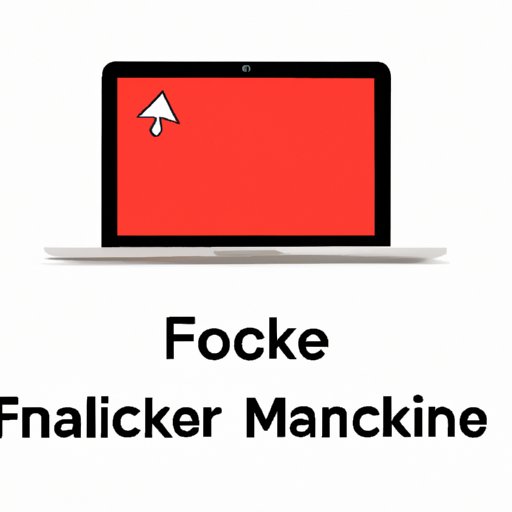Introduction
Have you ever encountered an issue with your MacBook and wanted to access a hidden file but couldn’t find it? Hidden files are a common occurrence on MacBooks, but they’re kept hidden from view for a reason. In this article, we will walk you through everything you need to know about showing hidden files on a MacBook, including beginner’s guide, simple tweaks and terminal commands, the definition of hidden files, and different ways to access and manage them. So, let’s get started.
Beginners’ Guide to Showing Hidden Files on a MacBook: A Step-by-Step Walkthrough
The process of revealing hidden files on a MacBook can seem daunting at first, but it’s actually quite simple. Here are the basic steps that you need to follow:
- Open Finder on your MacBook.
- Click on “Go” in the menu bar and select “Utilities.”
- Open “Terminal” from the Utilities folder.
- Type “defaults write com.apple.finder AppleShowAllFiles TRUE” into the terminal without quotations and hit “Enter.”
- Hold down the “Option” key and right-click on the Finder icon in the Dock. Select “Relaunch” from the menu.
- Go back to the Finder window and open any folder to see hidden files and folders on your MacBook.
If you encounter any issues during the process, don’t worry. Here are some tips to help troubleshoot:
- Make sure you typed the command without quotations correctly.
- Restart your computer and try again.
- If you don’t want to use Terminal, you can also use
Command + Shift + .to toggle hidden files visibility in the folder.
Uncovering Hidden Files on macOS: Simple Tweaks and Terminal Commands to Try Out
If you’re feeling adventurous, there are some additional tweaks and terminal commands that you can try to further reveal hidden files on a MacBook. Here are some examples:
defaults write com.apple.finder AppleShowAllFiles FALSE: This will hide the files again.killall Finder: This command will force Finder to restart.chflags nohidden [file]: This command will reveal a specific hidden file.
Keep in mind that some of these tweaks and commands can have unintended consequences. Never modify or delete a file unless you’re sure of what it is and what it does.
What Are Hidden Files on Mac and Why Are They Hidden? Learn and Reveal Them with Ease
Hidden files are files and folders on a MacBook that aren’t normally visible to the user. They’re hidden for a reason, typically to protect the user from accidentally modifying or deleting important system files.
While hidden files may seem mysterious and alluring, be cautious when working with them. Making changes to files that you’re not familiar with can cause system instability and may even render your MacBook unusable.
Showcasing Elusive Files: 5 Ways to Access and Unhide Hidden Files on Your MacBook
There are several different methods that you can use to access and reveal hidden files on your MacBook. Here are five of the most common:
- Using Terminal: As outlined in the previous steps, Terminal is the most basic way to show hidden files on your MacBook.
- Using a Keyboard Shortcut: You can toggle hidden files visibility by pressing
Command + Shift + .in any folder. - Using a File Manager App: Apps like FileZilla, Cyberduck, and Forklift have the option to toggle hidden files visibility from their menu.
- Using the Go To Folder Feature: Press
Command + Shift + Gand type the path of the folder you want to access in the prompt. - Disabling System Integrity Protection: This method is a bit extreme, but it disables the protected system folders and allows full access to the files.
It’s important to note that different methods may work better for different users depending on their experience level and comfort with modifying their MacBook system.
From Automator to Third-Party Apps: Exploring Tools to Help You Unleash Hidden Files on Mac
If you’d rather not use Terminal or other standard file managers, there are several third-party apps that can make uncovering hidden files on your MacBook much easier. Here are some popular tools:
- XtraFinder: This app has an option to toggle hidden files visibility in the menu and offers additional features such as split view and colored labels.
- Onyx: Among other things, Onyx offers a simple one-click option to reveal hidden files on a MacBook.
- Hazel: This app has a built-in feature to make file extensions, invisible files, and folders visible. It can also automate many file management tasks.
- CleanMyMac X: With a user-friendly interface, this app has an option to show hidden files on your MacBook and can also perform many other maintenance tasks.
Each tool has its own set of advantages and disadvantages, so it’s important to choose one based on your needs and experience.
Everything You Need to Know About Showing Hidden Files on macOS: An In-Depth Tutorial and Troubleshooting Guide
If you’ve made it this far and still need more help revealing hidden files on your MacBook, don’t worry. In this comprehensive tutorial, we’ve covered everything from the basics of showing hidden files to advanced tweaks and third-party apps that can streamline the process.
Along with this tutorial, we’ve also provided detailed troubleshooting tips and solutions for common issues that users may encounter when working with hidden files on their MacBook.
Conclusion
Now that you have a better understanding of how to reveal hidden files on your MacBook, it’s time to dive in and start exploring these elusive files. Whether you’re a beginner or an advanced user, there are many methods and tools available to help you achieve your goals.
Remember to use caution when working with hidden files and be sure to follow the instructions closely to avoid causing any damage to your MacBook system.
